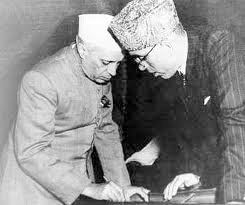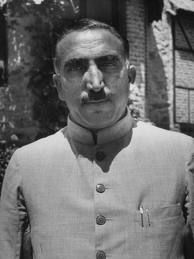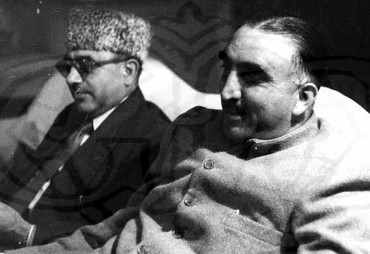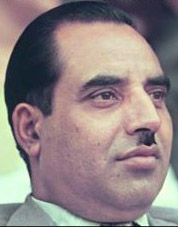Peace Watch » Editor's Take » Poor Kashmir Chief Ministers
Poor Kashmir Chief Ministers
I have no incisive study of the governance in the state. The state administration has not been what in journalistic parlance is termed as ‘my beat’. If the state is governed badly or very badly or governance in the state is conspicuous by its absence, I cannot say with absolute authority. That I believe is the domain of the “Peter Duckers” in the media. However, to my understanding the governance in the state cannot be delinked from its larger political narrative. 
On October 30, 1947, New Delhi installed Sheikh Muhammad Abdullah as the first chief administrator; on August 9, 1953, it dismissed Abdullah and placed Bakshi Ghulam Mohammad in the saddle. Towards the close of 1963, in New Delhi’s estimation Bakshi lost his utility, like his predecessor in office led him to the exit door. On 29 February 1964 in his place, it installed Ghulam Mohammad Sadiq with “only six members support in the assembly”. A year later, when Bakhsi on the strength of support in the state assembly claimed the throne, he too was jailed in the ‘national interest’. The Sadiq cabinet did not decide about arresting once New Delhi’s man Friday. Nevertheless, the decision was taken inside the Karan Mahal. Those present in Karan Mahal were ” Mr. Shankar Prasad, Sushital Banerjee, D..I.G and Joint Director IB.”
A big drama was enacted towards the end of 1968 for removing Sadiq from office and installing Mir Qasim. However, for the intervention by a friend of Mrs. Gandhi close to Sadiq it did not happen and he continued in office for three more years. Syed Mir Qasim was installed on 12 December 1971. On February 25, 1971 under a different plea and in a different removed him also. Once again, New Delhi appointed Sheikh Abdullah to the coveted position of the chief administrators. The story of dismissal and appointment of Abdullah scions as told by Farooq Abdullah in his book My Dismissal tells its own tale of ‘hire and fire’.
The stories of installations and dismals did not end there but continue to fill the footnotes of our contemporary history, perhaps will continue to adorn the footnotes for many more years. On the phenomenon of New Delhi installing and dismissing ‘chief administrators’ in the state Syed Mir Qasim in his autobiography provides us some good insight:
“To put this in perspective, I must inform my readers that whenever New Delhi feels a leader in Kashmir getting too big for his shoes, it employs Machiavellian methods to cut him to size. This it does by projecting a lesser leader as an alternative with the help of two-way overt and covert campaign – one, by convincing the targeted leader that his position was unassailable and lesser leader was conspiring against him; and, second by telling the lesser leader one that he was more popular than the main leader who had outlived his utility. Tale-tellers, of whose black art one heard in Mughal Courts, play a major role in this kind of conspiracy.” (Page 119)
 Quote from Syed Mir Qasim’s biography in fact sums up the entire gamut of power politics in the state. That despite “much water having flown down the Jhelum” has not changed. In fact, every change of guard in Jammu and Kashmir has its own story to tell. In this bizarre scenario of appointments and dismissals of chief administrators, it would be tomfoolery to look for man like Sir Albion Banerjee (January 1927-March 1929) amongst these ‘administrators’ and draw a distinction between a man of high qualms and low scruples. It would be equally an exercise in evasion to attempt at drawing a distinction between one ‘administrator’ being shade better than other.
Quote from Syed Mir Qasim’s biography in fact sums up the entire gamut of power politics in the state. That despite “much water having flown down the Jhelum” has not changed. In fact, every change of guard in Jammu and Kashmir has its own story to tell. In this bizarre scenario of appointments and dismissals of chief administrators, it would be tomfoolery to look for man like Sir Albion Banerjee (January 1927-March 1929) amongst these ‘administrators’ and draw a distinction between a man of high qualms and low scruples. It would be equally an exercise in evasion to attempt at drawing a distinction between one ‘administrator’ being shade better than other.
Two statements one by Syed Ali Shah Geelani Chairman (APHC H) and another by Mirwaiz Mohammad Umar Farooq, Chairman APHC (M) made me to revisit the whole phenomenon of appointments and dismissals of ‘chief administrators’ in the state.
Pradesh Congress leader S.D. Soz demanding granting of citizenship in the state to 1947 refugees from then West Pakistan provoked the statement of Syed Ali Geelani. Granting citizenship to non-state subjects refugees seen as a major move at changing demography of the state has been hanging fire in the state for past sixty-five years. “Pro-accession” leaders other than those belonging to the Hindutva parties have all along opposed it. The statement of Geelani reads:
“By articulating demand of granting state subject to 1947 non-state subject refugees before Sonia Gandhi and Manmohan Singh wants to realize dream of becoming Chief Minister of the state through short cuts and proving more loyal than king.”
Mirwaiz’ statement came in the wake of the Congress-National Conference administration in the state making a history of sorts by stopping the Hurriyat, JKLF and other leaders from saying thanks giving prayers after the holy month of Ramada. In post, 1947 history there is no precedence of preventing political opponents from saying Eid prayers. In keeping with the solemnity of the day, the precedence had been releasing of the political prisoners on the eve of Eid – sometime en masse. The agonistic and secularists, all respected the larger public sentiment on the day. Mirwaiz statement reads as:
“Bureaucrats in Jammu and Kashmir are interfering in sensitive religious matters.”
Some officers have been thrust upon us. They do not have the understanding of religion. These people are supervising religious interference in Kashmir. Conspiracies are being hatched to undermine the Islamic teachings in Kashmir. We will expose all such conspiracies. Actually it is the government which has given them free hand to interfere in religious matters,”
On the face of it, there are two different causes for the statements made by Geelani and Mirwaiz but once looked through prism of the state polity the two also converge at one point that is the phenomenon of ‘appointments and dismals’ that runs parallel to the popular narrative of the state. The real authorities to subvert and erode the larger narrative of the state have always effectively used this phenomenon. History of past sixty-five years is full off instances to illustrate this point of view; glaring ones are the role played by Bakshi Ghulam Muhammad after his installation as ‘administrator’ in getting the “constituent assembly” after installation of Bakshi and that of the State Assembly after appointment of Sadiq in eroding autonomy of the state.
To cap it, the APHC leaders are yet to learn that dams are not raised for stemming the flow of muddy waters through rhetoric’s.
Z.G. Muhammad Published Greater Kashmir August 27,2012
Filed under: Editor's Take · Tags: cheif minister, Kashmir, omar abdullah







